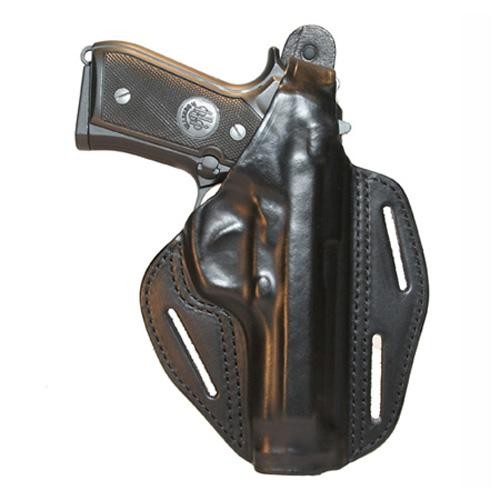At GunDigest, we independently review products. However, we may earn a commission when you purchase through links on our site. Learn More
How to Pick Your First Concealed Carry Holster

A Gun Digest reader asks, “I’m taking my first concealed weapons class with a small frame 9mm pistol. Can you recommend a specific holster to get started?”
Great question. I can point you in a general direction but holster selection is like dating success: highly subjective and dependent on many factors. So don’t be surprised if you end up shopping around some.
To start with, focus on four things: (1) leather, (2) belt mount, (3) high ride, and (4) thumb snap. Several excellent manufacturers (Bianchi, Galco, De Santis) offer models with all four of these features.
And here are the reasons. When you start carrying concealed regularly—and you should carry more days than not if you are truly serious—don’t be surprised if you feel awkward, uncomfortable and self-conscious. These are common and perfectly contextual reactions. Flow with them. They will pass with experience, but do take them into consideration in first holster (and gun) choice.
I recommend leather because it conforms over time to your use.
I suggest an integral security strap that releases with a thumb snap, because it is common for new shooters to worry about the gun somehow coughing itself up and out of the holster. The strap is mostly psychological but it is comforting for most new users I chat with.
“High ride” means that the gun should ride with half of its weight even with or above the belt loops. This tucks the mass of the gun just below the ribs and for many people is a much more comfortable carry position when seated.
Women may find lower carry more comfortable. Because females tend to have shorter torsos, and broader hips than men (pelvic arch) they are often advised to choose a low ride holster to keep the handgun from poking into their rib cage. But with a small frame revolver—my recommendation for most women—the curved grip still rides well in a high ride design because of the shorter barrel. Low ride favors standing, high ride favors sitting.
Choosing between outside-the-waistband (OWB) and inside-the-waistband (IWB) is also highly subjective. After many years of leather OWB I went “minimal” and used a soft neoprene IWB with my Model 60 or my SIG 239, .40. This was so comfortable a carry method I would actually forget I had the gun on. The tactical problem is that if you have to pull your gun to deter an attack, it is near impossible to re-holster it easily because the neoprene collapses. With gun out, if you’re a cop and have a badge to “windmill” when the police come you’re in good shape, if you don’t you will probably get proned-out and be subject to some rather dramatic language.
I really like the OWB Kydex-type holsters except that I can’t find one that fits my Ruger SR9C (my current “little buddy”) with laser designator. Generally speaking, IWB seems more comfortable and OWB seems more tactical. If you carry every day in a “high risk” environment then I would say go OWB. However, if you carry “just in case,” try IWB.
One additional tip: Be sure to check out the articles and blogs at gundigest.com and feel free to post questions there. I’m sure many of our readers will have other good opinions.
Holster Your Doubts: Mastering Concealed Carry
- CCW CCW Holsters for Women
- Concealed Carry Gun Holster
- Best Concealed Carry Pocket Holster – Options For CCW
- Most Comfortable Shoulder Gun Holsters
- What is an AIWB Holster? – Pros & Cons
- Best Concealed Carry Fanny Pack – Pros & Cons
Next Step: Get your FREE Printable Target Pack
Enhance your shooting precision with our 62 MOA Targets, perfect for rifles and handguns. Crafted in collaboration with Storm Tactical for accuracy and versatility.
Subscribe to the Gun Digest email newsletter and get your downloadable target pack sent straight to your inbox. Stay updated with the latest firearms info in the industry.